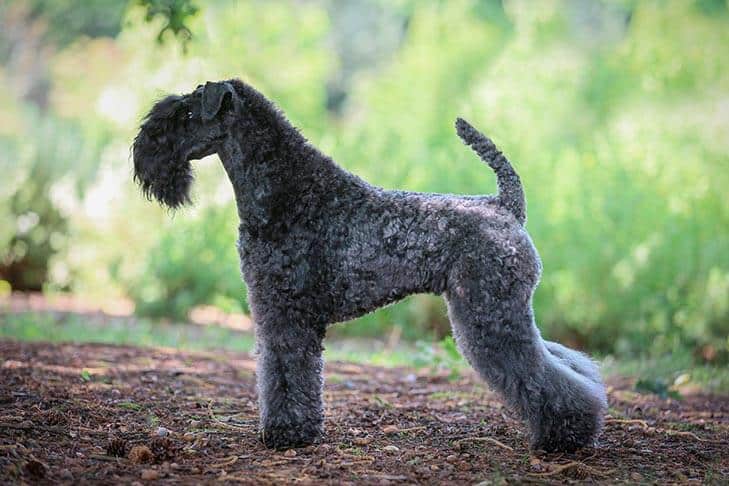
Home » Judging the Kerry Blue Terrier

Judging the Kerry Blue Terrier | The Kerry Blue Terrier is a long-legged Terrier that originated in southwestern Ireland, sometime in the late 1700s or early 1800s. It was developed as a multipurpose farm dog, and was used by mostly peasants to hunt vermin, guard livestock and serve as a companion dog. The General Appearance section of the US Kerry Blue Terrier standard highlights key elements of the breed:
Proper balance and proportions, correct movement for a long-legged Terrier and the breed’s hallmark coat are items to be particularly stressed.
Judging the Kerry Blue Terrier – Body Structure
The standard does not specifically describe body proportion; Kerries are slightly longer than square (height versus length). Square Terriers include Lakeland Terriers and Miniature Schnauzers—Kerries do not have this square proportion. But they are also not long-backed. They are not low-slung (short leg length in relation to back length). The neck is to be clean and moderately long—well set and carried proudly. A short-necked Kerry will look long-backed and often will have upright shoulder angulation.
The chest is deep/moderate breadth, ribs fairly well sprung/deep rather than round. Slab-sidedness is faulty. Shoulders should be long and sloping, well laid back. The front assembly of a Kerry is more like a sporting/working dog; it does not have the shortened forearm of the Fox Terrier—which is reflected in its movement.
The back is short, strong and straight (level) (note: short back not referring to overall dog length). There is a slight tuck-up, short loin. The dog should not be waspy-waisted. Tail set on high, moderate length, carried gaily erect/the straighter the tail the better. This does not mean long tails. This does not mean tails curving to the side like a Chinese Shar-Pei. There are dogs that are un-docked that have moderate tail length and proper carriage.
Judging the Kerry Blue Terrier – Movement
Kerry Blue movement is more akin to sporting/working dog movement than movement seen in Fox Terriers. They do not have a shortened forearm/humerus. Restricted reach and drive in the breed is faulty. Gait should have full freedom of action. Kerries do not goose-step in a pendulum motion when moving in the front—there is a bend of elbow and pastern which then extends out to full extension and reach. A problem seen in the breed is poor front movement often related to poor angulation—restricted reach in the front is the result. This is a difficult fault to breed out of—it often takes generations. Hindquarters are strong and muscular and provide the power for good reach and drive during motion.
Be cautious of over-angulation of the rear assembly. When viewed from the side during motion, the reach in front and the extension of the rear on the same side should be nearly equal, forming a “triangle” in appearance at the point of full extension. A good moving Kerry will reach in front to the level of the nose, or even past. Dogs with good reach and drive will have a tendency to drop their head down when moving; those carried high may be ewe-necked or straight shouldered. When viewed moving from the front or rear, the Kerry does not double-track; there is some tendency towards convergence in the cent (but not true single-tracking either).
Judging the Kerry Blue Terrier – Coat and Color
Proper type in the Kerry requires proper coat texture and color. It is one of the breed’s defining hallmarks.
The standard states the coat is to be soft, dense and wavy. A harsh, wiry, crispy, or bristle coat is to be severely penalized. There are too many Kerries being shown (and often rewarded) that support a wiry, nappy, tight-curled, harsh or bristle coat. Coats that are “packed” by their groomers like a Poodle coat should be heavily penalized. The body coat should have the required wavy coat—visualize a “Marcel” or pinched wave.
An excellent coat will have row after row of rippled waves. The coat is a single coat—no undercoat. There is no such thing as an “open” coat. The beard is blown dry straight, or left natural with a slight wave. The upper part of the legs have a wavy coat; the lower legs are blown dry straight and sculpted. Lighter colored dogs (silver, silver-blue, silver grey) often have a tendency to have looser waves, while darker-colored Kerries (darker grey-blue, slate blue) tend to carry a denser coat with tighter waves (but not small/tiny waves). Light silver Kerries used to have a tendency to have a cotton-textured coat, but not so much anymore. Darker Kerries should not have a packed—Poodle type coat.
The coat is hand scissored—not clippered. The only areas clippered are the neck, ears, sides of the head, between the foot pads, the abdomen and below the anus/scrotum/vulva. Talented groomers can hide a number of faults with clever scissoring—you must go over the dogs with your hands.
The color range is broad: from silver, to silver-blue and silver-gray, to blue-gray and into slate blues. Slate blues are not black. In natural light, slate blues will show a bluish hue and colored hairs can be found dispersed throughout their body coat. A Kerry is born black and develops its color as it matures. Some bloodlines are slow in developing color, but will eventually get color at an older age. Up to 18 months of age in the young dog, black is permissible. A black dog 18 months of age or older is to be disqualified. A white mark on a black dog over 18 months of age does not constitute clearing or mature color and the dog is to be disqualified. Some lines support a black mask on the head, with or without dark points on the lower legs. Black on the muzzle, head, ears, tail and feet is permissible at any age.
In judging light-colored dogs, black marks may be present that have occurred due to previous injury to the skin—the hair at the healing area may come in darker or black, the dog should not be penalized. Puppies and juveniles that display an almost human-like hair textures will develop into the proper coat as an adult. The hair tends to lie a little flatter on the body and leg areas. Puppy and juvenile coats are transitional, or clearing, until they reach an age of about 18-24 months (some bloodlines are even slower). The transitional stage may display a tan or brownish color tinge—this clears out as they mature. They may also have color splotching, uneven coloring or unusual color-turning patterns as juveniles. There is no such thing as a parti-color in the breed. Kerries may have a small white spot on their chests.
Judging the Kerry Blue Terrier – Heads
The head is long, but not exaggerated and is in good proportion to the rest of the body. Well-balanced, with no apparent difference between the length of skull and fore-face. A lack of back skull is a fault. Cheeks should be clean and level, free from bumpiness. The zygomatic arch should be flat, not protruding. The ears are V-shaped, small but in proportion to the size of the head. A small, flying ear and a high breaking set, as in the Fox Terrier, is foreign to the Kerry head and expression. Ears are carried close to the cheeks with the top of the folded ear slightly above the level of the skull. Ears that are not reaching the cheeks, but end above the eyes are incorrect. A dead, hound-like ear is very undesirable. Kerry ears are partially man-made; puppy ears are glued to create the correct ear set. Some forgiveness may be needed if ears are not perfect.
Avoid snipey muzzles. Correct bites are either scissors or level. Large, round, or light eyes are faulty. The silver, silver-grey, silver-blue, lighter gray dogs will usually have eye coloring lighter than the darker-hued Kerries. When viewed from the front, the Kerry head should be rectangular (or brick) in shape, sitting on an arched neck .Heavy heads, short heads, cheekiness, bumpy domed top skull, short back skull, hound ears, flying ears, high-breaking ears, light eyes, too wide/breadth of skull, down face, snipey muzzle, lack of beard and eyebrows are all faults when looking for the “perfect” head.
Judging the Kerry Blue Terrier – Size
The most common problem involving size in the breed are oversized dogs; rarely do you see an undersize dog. Kerries the size of Airedales are atypical for the breed—the standard addresses this specifically, even though there is not a size disqualification. Dogs over 20 inches or under 17½ inches and bitches over 19½ inches and under 17 inches are to be severely penalized—please read the standard for size descriptions. Legs should be moderately long with plenty of bone and muscle.
Judging the Kerry Blue Terrier – Temperament/Sparring
Kerry Blues are spirited, energetic dogs—they often show such temperament in the show ring. They should not be vicious or show biting or attacking behavior. Dogs that bite people in the ring should be dealt with in accordance with AKC rules and procedures. Vicious, uncontrollable dogs should be excused from the ring in accordance with AKC rules and procedures. When sparring Kerries, be sure to have plenty of space between dogs. Spar two at a time—bring the dogs from opposite sides towards each other, but keep four or more feet between dogs when sparring. Kerries are fast and will try to nab a beard (or more) if allowed to do so. It is recommended to spar males with males, bitches with bitches. Males may not want to spar with a bitch. Be weary of novice handlers that may not know how to spar Terriers. Do not let handlers get the dogs too close to each other.
Kerry Blues are spirited, energetic dogs—they often show such temperament in the show ring. They should not be vicious or show biting or attacking behavior.
The Kerry Blue Terrier Illustrated Standard states the following: at a dog show, a judge should put to the side any exhibitor who allows a Kerry to lunge and snarl. This is not typical of good Kerry temperament—Kerry Blues should be sparred. “If they eye each other intently, throwing themselves forward on their front toes, arching their necks, raising their ears to proper Kerry position, stand taut and ready for anything, each waiting for the other to make the first move and when, neither does, if they wag their tails, turn slowly and return happily to their places, then they are truly Kerry Blue Terriers.” This is a quote by Dr. E. S. Montgomery, author of the original KBT book.
In summary, remember that balance, correct movement, proper coat and color and correct temperament are very important factors in your judging. The Kerry Blue Terrier is a wonderful breed and a lot of fun to judge—an outstanding specimen can take your breath away. Your educated decisions will be well received by exhibitors.
